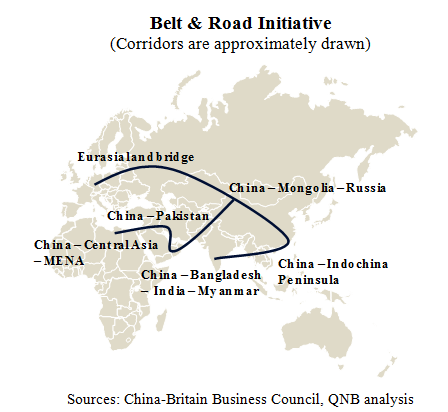A new economic order is emerging as China presses ahead with its Belt & Road Initiative (BRI). Nearly 40 world leaders and some 5,000 delegates gathered in Beijing for the second BRI Summit late last month.
First launched in 2013, the BRI is a Chinese-led global programme inspired by the old Silk Road and aimed at promoting connectivity, trade and capital flows between Asia, Africa and Europe. The “Belt” is comprised of overland projects connecting China to Europe via Central Asia and the Middle East, while the “Road” refers to projects associated with maritime routes linking China with Africa and the Middle East via Southeast Asia and South Asia. At the time of writing, China has signed BRI-related cooperation agreements with 126 countries and 29 international organizations. More than 60 countries are formal participants of the BRI, representing 2/3 of the world population and more than ¼ of global GDP. China’s president Xi Jinping often refers to the RBI as “the project of the century.”
The RBI is China’s most important global initiative. The massive infrastructure programme is expected to generate direct trade and investment opportunities for China, easing the transition from a capital intensive to a more consumption-based growth model. Our analysis delves into the trade and investment aspects of the BRI for China, illustrating the discussion with the introduction of a few key projects.
On the trade side, BRI offers an important avenue for China to increase its exports and imports from neighbors and other key partners. Both the “Belt” and the “Road” converge towards China’s mainland, shortening delivery times and improving Chinese access to different markets, including under-served frontier and emerging economies. This will likely produce trade growth by increasing trade volumes from and to China. Moreover, roads, railways, ports and other infrastructure-related projects often demand a large number of goods and services in which China is competitive, including construction and heavy manufacturing. This is ever more important for China as the country’s investment-driven growth has led to capital misallocation and excess capacity in those sectors. By creating additional demand for infrastructure, China will boost its exports in some of the sectors where it is most needed.
On the investment side, the BRI offers sizable opportunities for an efficient allocation of Chinese resources. The surplus of domestic savings is still substantial in China. Rebalancing towards consumption is occurring but not in a fast enough pace to materially reduce the savings glut. Policymakers could see outward investment into what is largely Chinese-led projects as an important avenue to direct those savings.
Belt And Road Initiative

(Corridors are approximately drawn)
Sources: China-Britain Business Council, QNB analysis
On the project side, there are several major enterprises either under construction or already in the pipeline. In Pakistan, China is leading the transformation of the southern port of Gwadar into an energy hub linking China to the Middle East. This involves road and pipeline networks stretching from Gwadar to western China, reducing a 12,000km journey to import hydrocarbons by sea to less than 3,000km over land. Work on the road network and port expansion have already begun. Other important BRI port projects include investments in Brunei, Sri Lanka, Greece, and Belgium. In Indonesia, the 142km Jakarta-Bandung high-speed railway is currently under construction and is set to become the first foreign line to use China’s high-speed railway standards, technologies and equipment. Other promising flagship BRI railway projects include the Nigerian Abuja-Kaduna railway and bilateral railways between China-Laos and Ethiopia-Djibouti.
The first BRI summit was held in Beijing in May 2017, when the global infrastructure programme was boosted by additional investments and new members. During the second BRI summit, China wanted to further strengthen the environmental and financial sustainability of BRI projects. In our view, Chinese authorities seem to be interested in mitigating potential project risks by increasing transparency, stakeholder engagement, compliance and environmental long-term sustainability. This will likely be supported by newly founded official financial institutions, including the Asian Infrastructure Investment Bank (AIIB), the Silk Road Fund and the New Development Bank (NDB).
All in all, the BRI is set to provide a “big push” for infrastructure investments in frontier and emerging markets. As China recalibrates the BRI with enhanced project governance, even advanced economies and G-7 countries such as Italy, Germany, Belgium and Greece become more engaged. This is particularly good for Beijing in a period in which economic disputes with the US are still creating jitters.
